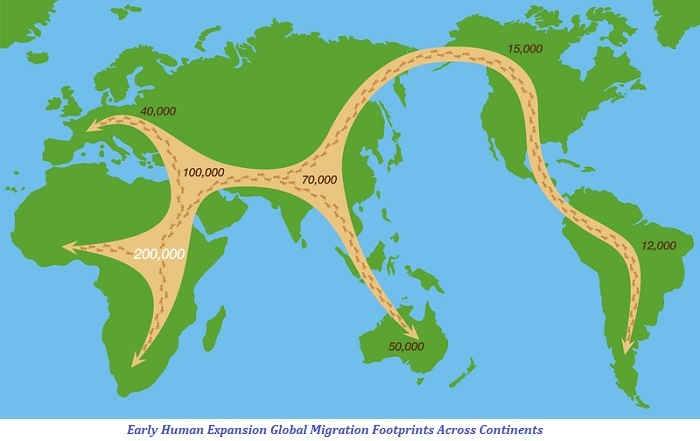

Plio-Pleistocene hominids are a group of human ancestors that lived during the Pliocene and Pleistocene epochs, which spanned from approximately 5 million to 11,700 years ago. During the Pliocene and Pleistocene, hominids underwent a series of significant evolutionary changes, including the development of larger brain sizes, the evolution of bipedalism, the appearance of stone tool technology, and the colonization of new habitats. These changes allowed hominids to diversify and adapt to a range of environments, from the open savannas of Africa to the forests and highlands of Asia and Europe.

Miocene hominoids are a group of primates that lived during the Miocene epoch, which lasted from approximately 23 to 5 million years ago. This group includes the early ancestors of modern apes and humans. Some well-known genera of Miocene hominoids include Proconsul, Kenyapithecus, and Dryopithecus. These primates were characterized by adaptations for climbing, such as long arms and opposable thumbs, and showed a diversity of cranial and dental features.
Dryopithecus is an extinct genus of primates that lived in Europe and Asia between 10 million and 7 million years ago. They are considered to be some of the earliest members of the hominid lineage, which includes modern humans and their extinct relatives.
Some notable characters of Dryopithecus include
Large cranial capacity − Dryopithecus had a larger cranial capacity compared to other primates of their time, suggesting the presence of a relatively large brain.
Grasping hands and feet − They had opposable thumbs and big toes, which suggest adaptations for climbing and grasping onto branches.
Fossil distribution − Dryopithecus fossils have been found in multiple locations in Europe and Asia, indicating a wide geographic distribution and suggesting they were a successful species in their time.
Ramapithecus was a genus of hominoid primates that lived approximately 14 million years ago in the Late Miocene period. The following are some of the characters associated with Ramapithecus
Primates − Ramapithecus is considered one of the earliest hominoids and is believed to be a direct ancestor of modern apes and humans.
Dental Characteristics − Ramapithecus had large canine teeth, molars with thick enamel, and an elongated lower jaw. These dental characters suggest that Ramapithecus was an omnivorous or herbivorous primate.
Cranial Characteristics − Ramapithecus had a relatively small braincase and a prominent brow ridge. It also had a distinct cranial crest that served as an attachment site for strong jaw muscles.
Fossil Records − Ramapithecus fossils have been found in Asia and Eastern Europe and are considered important evidence in understanding human evolution.
Debated Ancestry − The exact ancestry of Ramapithecus is still debated, with some scientists considering it as a possible ancestor of the orangutan and others as a possible human ancestor.
Australopithecines were a group of hominids (human ancestors) that lived in Africa between 4 and 2 million years ago. They are characterized by the following features
Bipedalism − Australopithecines were fully bipedal, meaning they walked on two legs, which is a key characteristic of early human ancestors.
Cranial anatomy − Australopithecines had small brains compared to modern humans, but had a cranial anatomy that was well adapted for bipedalism, such as a shortened snout and a foramen magnum (hole in the skull) that was positioned beneath the skull.
Teeth − Australopithecines had large canine teeth, but their molars were relatively small and similar in size to those of modern humans.
Limb proportions − Australopithecines had long, robust arms that were adapted for climbing trees, but their legs were much longer in proportion to their body than those of modern apes.
Pelvis − The pelvis of australopithecines was wider and shallower than that of modern humans, which was necessary to accommodate their bipedalism.
T. Robinsons's dietary hypothesis is a theory proposed by Tim D. White, a paleoanthropologist, that suggests that changes in diet were a major factor driving the evolution of early human ancestors.
According to this hypothesis, the shift from a primarily herbivorous diet to a more omnivorous diet played a critical role in the development of the genus Homo, which includes modern humans.
The dietary hypothesis suggests that the increase in dietary breadth and flexibility allowed early hominids to access a wider range of food resources, which in turn led to an increase in brain size and the development of new adaptations for tool use and meat processing.
This increase in dietary quality and brain development, in turn, led to a suite of adaptations that facilitated the evolution of Homo, including increased body size, increased brain size, and improved hand and foot anatomy for bipedalism.
Overall, T. Robinsons's dietary hypothesis highlights the important role that diet played in the evolution of early human ancestors and the development of the genus Homo.
During the Pliocene and Pleistocene, hominids underwent a series of significant evolutionary changes, including the development of larger brain sizes, the evolution of bipedalism, the appearance of stone tool technology, and the colonization of new habitats. The study of Miocene hominoids provides important insights into the evolution of primates and the origins of the hominid lineage. T. Robinsons's dietary hypothesis highlights the important role that diet played in the evolution of early human ancestors and the development of the genus Homo.
Q1. What locations have australopithecines been discovered?
Ans. Fossils of Au. afarensis have been discovered in Ethiopia, Kenya, and Tanzania.
Q2. Who were Homo habilis men?
Ans. Homo habilis is an extinct species of human that lived approximately 2.8 million to 1.5 million years ago in East Africa. It is considered the first species of the genus Homo, and the first to possess uniquely human characteristics.
Q3. What do you mean by cranial capacity?
Ans. Cranial capacity refers to the volume of the interior of the skull, which houses the brain. It is an important factor in determining the overall size and anatomy of the brain. Cranial capacity is measured in cubic centimeters (cc) or milliliters (ml).